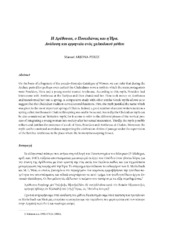| dc.contributor.author | Arjona-Perez, Manuel | |
| dc.date.accessioned | 2020-10-26T12:59:24Z | |
| dc.date.available | 2020-10-26T12:59:24Z | |
| dc.date.issued | 2017 | |
| dc.identifier.isbn | 978-960-85145-6-0 | |
| dc.identifier.issn | 2459-3230 | |
| dc.identifier.uri | https://hdl.handle.net/1956/24193 | |
| dc.description.abstract | On the basis of a fragment of the pseudo-Hesiodic Catalogue of Women, we can infer that during the Archaic period (or perhaps even earlier) the Chalcidians wove a myth in which the main protagonists were Poseidon, Hera and a young mortal named Arethousa. According to this myth, Poseidon had intercourse with Arethousa at the Euripus and then abandoned her. Hera took mercy on Arethousa and transformed her into a spring. A comparative study with other similar Greek myths allows us to suggest that the Chalcidian tradition served several functions. First, the myth justified the name which was given to the most important spring of Chalcis. Indeed, a good number of ancient writers mention a spring called Arethousa in Chalcis; this spring was said to be sacred. Secondly, the Chalcidian myth can be also considered an ‘initiation myth’, for it seems to refer to the different phases of the vertical process of integrating a young woman into society after her sexual maturation. Thirdly, the myth possibly reflects and justifies the existence of a cult of Hera, Poseidon and Arethousa at Chalcis. Moreover, the myth can be construed as evidence supporting the celebration of rites of passage under the supervision of the heroine Arethousa in the place where the homonymous spring flowed. | nob |
| dc.language.iso | ell | nob |
| dc.publisher | Norwegian Institute at Athens | nob |
| dc.relation.ispartofseries | Papers and Monographs from the Norwegian Institute at Athens | nob |
| dc.subject | Euboea Island - Archaeology | |
| dc.subject | Euboea Island - Religion | |
| dc.title | Η Αρεθούσα, ο Ποσειδώνας και η Ήρα. Ανάλυση και ερμηνεία ενός χαλκιδικού μύθου. | nob |
| dc.type | Chapter | nob |
